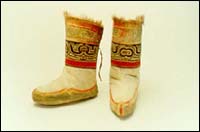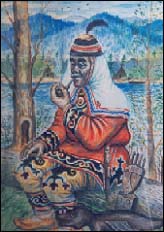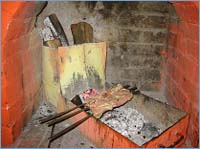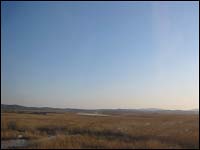 TRADITIONAL
COSTUMES TRADITIONAL
COSTUMES
|
Small ethnic groups in Primorsky Krai (colonized
by Russians in 19th century), include Nanaitsy,
who also live in Khabarovsky Krai, Sakhalin and
China; Tazy, who have Chinese roots, and Udegeitsy,
who also live in Khabarovsky Krai.

Tazy - formed in 1880s, from intermarriages between
Udegeitsy, Nanaitsy and Chinese - speak Chinese
with some words from Udegeitsy and Nanaitsy languages.
Udegeitsy live especially in Pozharsky region
of Primorsky Krai. Only 4 percents speak their
own language fluently, and no written version
is used. They are, by tradition, hunters and fishermen
and they used to have shamanism.

 RELIGION
RELIGION
|

In 2000, 199 religious organizations were registered,
representing 21 confessions. In order of number
of groups registered with Ministry of Justice
in 1999: Russian Orthodox (61), Presbyterian (30),
Evangelical Christian (21), Evangelical Christian
Pyatidesyatniki (18), Jehovah's Witnesses (12),
Methodists (8), Seventh Day Adventists (7), Evangelical
Christian Baptists (6), Buddhists (6), Roman Catholics
(5), Russian Orthodox Old Believers (5), Hare
Krishna (4), Islam (3), Evangelical Lutherans
(3), Judaism (2), Mormons (2), Armenian (1)
Taken from site www.fegi.ru/primorye
, created by the Far East Geological Institute.
 FOOD
FOOD
|
1. The best way, of course, to taste Russian
cuisine is to be invited to a home-cooked diner
rather than in a restaurant.
2. Foods vary from region to region but some well-known
dishes are the following ones: borsch (cabbage
soup), pelmeni (kind of ravioli), blini (pancake
you'll eat with caviar) and not forgetting Shachlyk
( Russia pork Kebab, best cooked outside!)
3. Local cuisine in the Russian Far East includes:
uha (boiled fish soup), grebeshki (scallops),
kalmar (squid), ikra (caviar), krasnaya ryba (smoked
salmon) ...
4. If you want to drink a beer ask for a pivo
(pronounce pivA); balzam is an alcoholic drink
made of different herbs. Of course this list will
not be complete without mentioning the vodka and
the samagon (very strong, so pay attention!).

Special to Far East are taiga plants, like ginseng,
limonnik (with red berries), which is used to
make liqueurs and teas - it's meant to give you
vitality. Ethnic group Nanaitsy say if you eat
a handful of dried limonnik berries, it gives
you energy to hunt all day without eating.
People grow zhimolost, which has dark blue berries
- you can eat it fresh or make jam or varenye
(a kind of more runny Russian jam).
People also pick fern shoots in the forest in
spring - when they are small and curly, and use
them in salads, and salt them. Korean-style salads
with carrot, seaweed, and squid are also famous
in the region. From the sea, people get crab,
shrimps, and different kinds of red salmon, scallops
and octopus.
 SOME RECIPES
SOME RECIPES
|
Cabbage Soup (BORSCH)
Traditional Russian soup by Natasha Bezuglova
Ingredients:
Cabbage 3/4 of the head
Carrot 1
Potatoes 3
Beetroot 1
Tomato 2
Tomato paste 2 tbl. spoon
Fresh sweet peppers 1/2
Meat (pork or beef) 400-500 gram
Lard 50 gram
Onion 1 head
Garlic 3 gloves
Dill or parsley
Sour cream or mayonnaise
Bay leaf 2 leaves
· Cut the meat into small square pieces (1
centimetre in diameter each) and put the meat into
a large cooking pot with boiling water (approximately
3 litres of water). Peel medium sized potato and
place it uncut into the pot with the meat. Boil
all ingredients for about 40 minutes on a medium
heat or gas mark 4.
· Chop the cabbage and cut the beetroot into
square pieces (similar in size to the meat). Then
place them in the pot
· Cut 2 medium sized potatoes into similar
pieces like the meat and put them into the pot 10
minutes after you start to cook the cabbage and
beetroot.
· Cut half of the medium sized sweet pepper
and place it in the pot five minutes after the potatoes.
Cut 3 tomatoes and mix them into the cooking pot
also.
· Meanwhile grate one medium carrot. Cut
several gloves of garlic into small shards and fry
whilst constantly stirring with olive oil in a frying-
pan. When the carrot and garlic are well fried and
soft, then add 2 spoons of tomato paste and continue
fry mixing them together for 1 minute. Than pour
all of this mixture to the cooking pot with meat
and other ingredients
· Take out the uncut potato that was placed
in the pot at the very beginning. Mash it thoroughly
and then return it to the pot as it gives a special
taste and thickness.
· Chop the onion and fry it with oil until
it is golden in colour. Put the onion to the pot
with the soup.
· Turn off the heat. Be careful to let the
borsch stand. Put the bay leaf and ground black
pepper into the pot and leave the borsch standing
for a further 5 minutes.
· Serve hot with chopped dill or parsley
with 1-2 tbl. spoon of sour cream or mayonnaise
per serving.
NB You should add salt to the soup when it is being
cooked according to your own taste
|
Russian pancakes (Bliney)
For 4 portions:
800 gram of flour
800 milligram of warm milk
4 eggs
50 gram of butter
1 tablespoon of salt
1 teaspoon of sugar
20 gram of yeast
Dissolve yeast in 600 milligrams of warm milk,
and then pour this mixture into the bowl with
flour.
Knead dough and put it into a warm place to let
it rise.
Separate the egg whites and the yolks. Mix the
yolks with the remaining 200 milligrams of milk
with the melted butter then add salt and sugar.
Pour the mixture into the dough, properly mix
and put into warm place to let it rise.
Beat up the egg whites and add to the dough just
before cooking. Fry pancakes in a well-oiled frying
pan.
Then eat and enjoy with Smetana (sour cream) or
with honey.
Traditional Russian salad (Olivier)
Ingredients:
Eggs
Carrots
Ham
Green peas
Onion
Potato
Mayonnaise
Salt
Cucumber
· Boil the carrots, eggs and potatoes then
let them cool.
· Cut ham, hard boiled eggs, potatoes,
carrots, cucumbers into small pieces (1 centimetre
in diameter each)
· Chop the onion
· Put all ingredients into a bowl then
add green peas, salt and mayonnaise.
Limonnik berries
You can put a few berries into a teapot of boiling
water and leave to stand - you get a pink drink,
tasting and smelling a bit spicy.
Kvas (Russian traditional drink) with Limonnik.
1 kg of rye crackers, 500 g sugar, 50g currants,
25g yeast, 1 table spoon of dried mint, 10-12
black currant leaves, a pinch of cinnamon, 50g
limonnik berries.
Dry the crackers in the oven, then put into a
large enamel pan, pour boiling water over them
and leave to stand for 10-12 hours. Place the
mint and black currant leaves in two separate
cups of boiling water to make a kind of tea. Strain
the crackers mixture through two layers of muslin,
and add the black currant leaf tea, sugar and
yeast. Mix it all well and leave to ferment at
room temperature for 5-6 hours. When the kvas
begins to foam, skim the foam off, and strain
again, and then pour into bottles, and add the
mint tea. Add several limonnik berries to each
bottle and cork well. If you drink half a glass
of this kvas every morning, it will have a good
tonic effect.
Varenye (a kind of a jam) from zhimolost berries.
1kg of zhimolost berries (freshly picked and not
too ripe), 1kg sugar, 1 glass of water, 2g citric
acid crystals
Make hot syrup from boiling water and sugar, and
pour over the berries, and leave for 4 hours.
When the berries absorb all the syrup, boil for
5 minutes, and then leave again for 5-8 hours.
Then add citric acid to avoid crystallizing, and
boil to the right consistency (the berries should
not float to the top).
Salted ferns.
Use 4kg of salt to 10g of fern shoots. Salt the
bottom of a barrel, then put in a layer of ferns,
then a layer of salt, in turn. Put a layer of
salt at the top and put a weight on top. In 3
weeks, prepare a salt solution with 1 -1.5kg of
salt to 10 liters of water. Pour out the old liquid,
and pour in new salt solution. Leave for another
3 weeks. Before using the fern in salads, soak
in water, and then bring the water to the boil.
Banyas.
One of the greatest Russian traditions is the
banya (equivalent to sauna). You can enjoy different
type of banya: public or private one. Public banyas
are equipped with separate rooms and pools for
each sex. Private banyas can be rented for a small
group of friends.
To enjoy it you have to follow some simple rules:
sit naked in the sauna until you sweat, go out
and jump into the cold water or take a cold shower.
This is only the beginning!!! After two or three
of these cycles, take the wet branches you'll
find in the sauna and start hitting yourself in
order to bring blood to the surface of your skin.
You can also put a mix of honey and salt all on
your body in order to stimulate your circulation
and leave your skin sweet.
Don' forget to drink water or tea and avoid alcohol!!
 SPORTS
SPORTS
|
Winter sports can be enjoyed in the region from
ice driving on Lake Yunost off Prospekt Stoletiya
in Vladivostok, on weekend day's races are popular
amongst locals that flock in crowds to see them.
For calmer activities, the older and occasionally
younger generations can bee seen scattered along
the coast line of Vladivostok city Ice fishing
for smelt (a small fish.) This sport is particularly
popular near mining villages in the north of the
Amur Gulf, as mines have closed, and there is
no way to earn money.


For hunting, the main trophy prey are elk, Manchurian
deer, wild boar, roe deer, dappled deer, brown
bear, hare, badger, fox, goose, duck, sandpiper.
Brown bear live in Anuchinsky, Chuguevsky, Olginsky,
Dalnerechensky, Krasnoarmeisky, Terneisky and
Pozharsky districts, Roe deer in Khasan, Ussurisk,
Nadedzhinsky, Mikhailovsky, Shkotovsky and Partizansky
regions. Wild boar can be found in Anuchinksy,
Partizansky, Lazovsky, Olginsky, Chuguevsky, Krasnoarmeisky
and Pozharsky districts, Dappled deer in Khasansky,
Nadezhdsinky, Ussurisky and Shkotovsky districts,
Elk are found in remote areas such as Krasnoarmeisky,
Pozharsky and Terneisky
(for more information go and visit the site on
tourism hunting http://www.mir1.ru/oxotatrof.html)
 LINGUISTIC SECTION by Irina Panteleyeva
LINGUISTIC SECTION by Irina Panteleyeva |
Table
|

